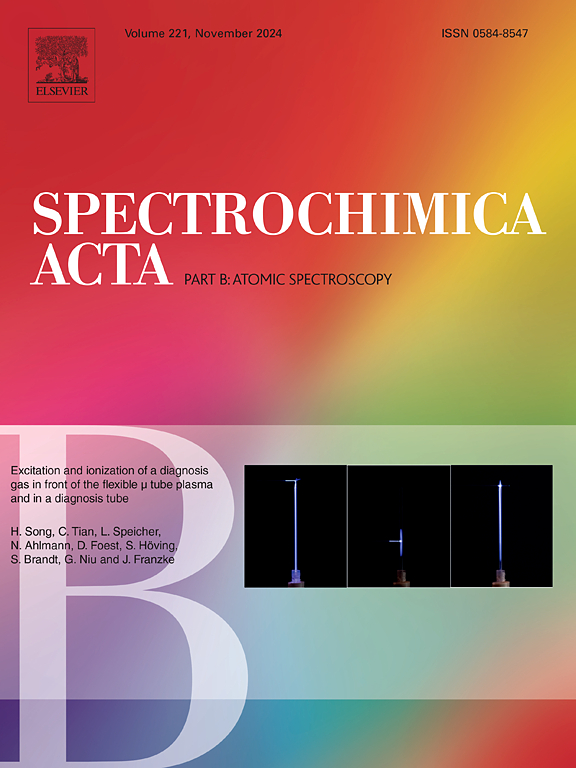Energy-dispersive X-ray fluorescence analysis of uranium-contaminated stainless-steel surfaces by eliminating the iron sum peak using a titanium filter
IF 3.8
2区 化学
Q1 SPECTROSCOPY
引用次数: 0
Abstract
During energy-dispersive X-ray fluorescence (EDXRF) measurements of stainless steel, sum peaks originating from iron are frequently observed. Among these, the Fe Kα + Kβ sum peak overlaps with the U Lα peak, complicating the analysis of uranium contamination on stainless-steel surfaces. While secondary X-ray filters can mitigate such sum peaks, integrating them into commercially available portable EDXRF analyzers poses technical challenges. This study presents a straightforward method for eliminating iron sum peak interference. A titanium foil, placed over the uranium-contaminated area on a stainless-steel surface, attenuates incident X-rays while allowing significantly higher transmission of U Lα X-rays than Fe K X-rays. EDXRF measurements were conducted on uranium-contaminated stainless-steel models using a portable EDXRF spectrometer equipped with a titanium foil of optimized thickness as a filter. In the resulting EDXRF spectrum, the intensity of the U Lα peak showed a direct correlation with the uranium content, enabling accurate detection of uranium levels as low as 61 ng. The proposed method achieves a uranium detection sensitivity approximately 100 times greater than conventional α-survey meter methods.

利用钛滤光片消除铁和峰对铀污染不锈钢表面的能量色散x射线荧光分析
在不锈钢的能量色散x射线荧光(EDXRF)测量中,经常观察到源自铁的和峰。其中Fe Kα + Kβ和峰与U Lα峰重叠,使不锈钢表面铀污染分析复杂化。虽然二次x射线滤波器可以减轻这种和峰,但将它们集成到商用便携式EDXRF分析仪中存在技术挑战。本文提出了一种直接消除铁和峰干扰的方法。在不锈钢表面的铀污染区域上放置钛箔,可以衰减入射x射线,同时使U - l - α x射线的透射率明显高于Fe - K x射线。使用配备优化厚度的钛箔作为过滤器的便携式EDXRF光谱仪对铀污染的不锈钢模型进行了EDXRF测量。在生成的EDXRF光谱中,U Lα峰的强度与铀含量直接相关,可以准确检测低至61 ng的铀含量。该方法的铀探测灵敏度比传统的α-测量仪方法高约100倍。
本文章由计算机程序翻译,如有差异,请以英文原文为准。
求助全文
约1分钟内获得全文
求助全文
来源期刊
CiteScore
6.10
自引率
12.10%
发文量
173
审稿时长
81 days
期刊介绍:
Spectrochimica Acta Part B: Atomic Spectroscopy, is intended for the rapid publication of both original work and reviews in the following fields:
Atomic Emission (AES), Atomic Absorption (AAS) and Atomic Fluorescence (AFS) spectroscopy;
Mass Spectrometry (MS) for inorganic analysis covering Spark Source (SS-MS), Inductively Coupled Plasma (ICP-MS), Glow Discharge (GD-MS), and Secondary Ion Mass Spectrometry (SIMS).
Laser induced atomic spectroscopy for inorganic analysis, including non-linear optical laser spectroscopy, covering Laser Enhanced Ionization (LEI), Laser Induced Fluorescence (LIF), Resonance Ionization Spectroscopy (RIS) and Resonance Ionization Mass Spectrometry (RIMS); Laser Induced Breakdown Spectroscopy (LIBS); Cavity Ringdown Spectroscopy (CRDS), Laser Ablation Inductively Coupled Plasma Atomic Emission Spectroscopy (LA-ICP-AES) and Laser Ablation Inductively Coupled Plasma Mass Spectrometry (LA-ICP-MS).
X-ray spectrometry, X-ray Optics and Microanalysis, including X-ray fluorescence spectrometry (XRF) and related techniques, in particular Total-reflection X-ray Fluorescence Spectrometry (TXRF), and Synchrotron Radiation-excited Total reflection XRF (SR-TXRF).
Manuscripts dealing with (i) fundamentals, (ii) methodology development, (iii)instrumentation, and (iv) applications, can be submitted for publication.

 求助内容:
求助内容: 应助结果提醒方式:
应助结果提醒方式:


